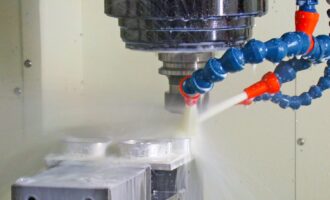The greatest lubricant innovation in the last decade
By Hank Hogan
Recently, F&L Asia posed this question in two LinkedIn discussion groups: What has been the greatest lubricant innovation in the last decade? As might be expected from a varied group scattered around the world, the responses covered everything from different types of lubricants and additives and how they are analysed to business models.
For instance, John Neale, director of a Birmingham, UK-based consultancy, pointed out that water-mix metalworking fluids use a combination of boric acid and formaldehyde to achieve bio-stability and long sump life. But that solution is now running into problems.
“There has been increasing concern over the last few years, due to testing associated with REACH in Europe about the toxicity of boric acid and formaldehyde,” Neale said.
That’s why for him, the greatest lubricant innovation is a boron-free additive which allows the formulation of water-mix metalworking fluids which are formaldehyde and boron-free, while still achieving long life. This is particularly important to smaller players, who lack research and development resources to come up with their own solution, Neale said.

Farrukh Jamal, commercial manager at Qatar Lubricants in Doha, nominated oil-soluble polyalkylene glycols (PAGs). These can be used as additives to enhance lubricant performance, as co-base oils or as substitute for more expensive esters.
Oil-soluble PAGs “have given lots of flexibility to formulators to develop new formulations by utilising the fringe benefits of all available synthetic technologies, the most common, in the market these days,” said Jamal.
The list of new formulations includes esters, Group III, gas-to-liquids (GTL) and polyalphaolefins (PAOs). This wide range of combination is possible because PAGs offer excellent compatibility with Group I to IV hydrocarbons, he said.
Samer Akram, director of operations at Unichem Services in Durban, South Africa, voted for synthetic and renewable non-hydrocarbon oils because such innovations fit the times and also align with where the global lubricants industry is headed, he said.
That direction is “smaller power units, generating more efficient power, putting greater demands on the lubricants used, with a greater emphasis on renewability and environmentally friendly technology,” Akram said.
Others mentioned synthetics as well. However, it was also pointed out that synthetics have been around for several decades. Thus synthetics, while not an entirely new innovation, could be considered an innovation whose time has finally come.

Another commonly mentioned area of innovation is analytical tools. David Pinchuk, CEO at Thermal-Lube of Pointe-Claire, Quebec, Canada, said improved analysis is a critical and important innovation because of what such capabilities make possible. Pinchuk noted these innovations offer “the ability to track lube degradation through analytical equipment.”
Rich Wurzbach, president of York, Penn., U.S.A.-based MRG Labs, explained his thinking behind the choice of analysis as the greatest innovation. “Regardless of the specific technology in lubricant base oils, additives and grease thickeners – which have all been greatly improved – performance is always dependent on having clean, unmixed and un-degraded lubricants in use. Advancements in sampling tools, sensors, grease analysis and instruments have all greatly enhanced the effectiveness and costs of properly monitoring all lubricants,” he said.
Wurzbach also pointed to work being done by standards bodies, with this helping in its own way as much as advances in technology. For example, he cited ASTM International’s , respectively, he said. Together with advances in monitoring and analysis technology, such standards mean that lubrication shortcomings can be more quickly discovered and corrected.
They also enable better field practices, such as when and how often lubrication or re-lubrication must be done. So, not only will machinery be better protected, its operation will be more efficient and cost effective as well, thanks to better analytical tools and techniques.

As for the future, ongoing technology advances will provide even more benefits, Wurzbach said. “Online sensors can further improve the efficiencies of lubricant analysis by monitoring in real time, and designating for sampling only those reservoirs where changing conditions dictate the need for the sampling and laboratory analysis of lubricant and machine condition,” he said.
A final group of respondents mentioned external factors and new business models as being the greatest lubricant innovation in the last decade. This might be, for example, an integrated service concept that includes advice and maintenance, in addition to lubricants sales. An alternative example could be government regulations which require greater vehicle fuel efficiency, which then spur improvements in capabilities and performance, and translate into better lubricants.
A third example along these same lines comes from Thomas Norrby, senior technical coordinator of naphthenics at Nynas AB in Stockholm, Sweden. He noted that there has been an ongoing substantial reduction in vehicle pollutants, with both NOx and particulate matter having both been cut dramatically, with more reductions on the horizon.

Behind such improvements is a fundamental change in how lubricants and the engines they protect are viewed. The two are no longer separate, but instead are co-engineered and evolve together.
“I would be referring to the view of ‘the lubricant as a machine element’ in its own right; something that is an integral part of the design and which cannot just be swapped for ‘another oil’,” Norrby said.
He added, “Thus, hardly my own original idea, but something that I like to teach and preach whenever I get the chance.”
As can be seen, there are many different views on this subject. So, what is the greatest lubricant innovation of this decade? The answer is somewhat like the fable about the blind men and the elephant. The description of the elephant from each of the blind men was incomplete, but the sum provided a total and complete picture. So the answer is perhaps all of the above are collectively the greatest lubricant innovation of the last decade.
echo '






